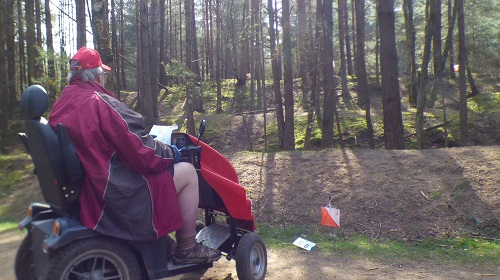

Do you like being outside but are you ‘physically challenged’ or have reduced mobility? Trail orienteering has been designed as a form of orienteering that allows equal participation for those unable to compete in the standard ‘foot’ orienteering (where running speed is an important factor).
In the TempO version of Trail Orienteering, there is no distinction between all those competing - competitors of whatever mobility have identical challenges. However, in the PreO version when competitors follow a course, although the challenges are the same, it is not possible to make the conditions identical. It is therefore common practice to provide a separate classification with 2 classes: Open (for any competitor) and ‘P Class’.
P Class eligibility
Although ‘physically challenged’ will include those who use a wheelchair, the concept covers a broad range of conditions. Internationally, the International Orienteering Federation (IOF) uses criteria to determine whether someone can compete in the P Class. For full details, see: IOF - Eligibility for P Class in TrailO (download the Eligibility Form and see, in particular, page 3)
In summary, an athlete who has a disability that significantly reduces his/her mobility shall be eligible. Typical examples of a disability that may give eligibility include:
The IOF criteria also comment that age, pain, lack of fitness, visual impairment or intellectual disability are not reason to qualify.
Finally, where the above examples do not apply, there is a quantifiable indication as to the interpretation of reduced mobility when a competitor is able to walk. This states that it means that the athlete needs more than 40 minutes to walk 2500 meters.
Note that when competing in major competitions, eligibility needs to be certified by a doctor and approved by the national federation.
Terrain factors
When a TrailO event is being planned (whether a PreO or a TempO event), consideration is given to making sure that the course is accessible for any P Class competitors. This normally requires that the route to be followed is one that the least mobile competitors, the person confined to and propelling a low fixed wheelchair and the person who walks slowly and with difficulty, can negotiate within the maximum time limit.
Any potential issues which have been identified will normally be indicated in the details of the event but the organisers will always endeavour to ensure it is fully accessible.

Peter Roberts competing at the British Championships in 2022
Event timing
As indicated above, when taking part in a TempO competition, the conditions are considered identical for all competitors (of whatever mobility). It is speed and accuracy of reaching a decision when seated in a fixed location that determines the best competitors.
In a PreO competition, competitors have to progress around a course. In the Open category, it is assumed that competitors are able to walk at a steady pace (but you will also see competitors running if they find they are short of time!). The time allocated is usually calculated as 3 minutes for each control plus 3 minutes for each 100 metres of the course. For those with reduced mobility, although presented with the same map reading challenges, additional time can be allocated depending upon various factors such as the amount of height gain over the course or the condition of the path. The organiser will specify the time allowed for both Open and P Class competitors in the event details.